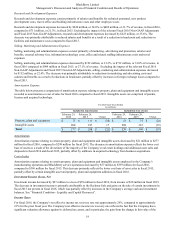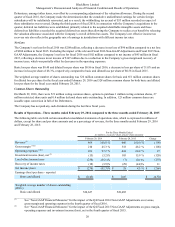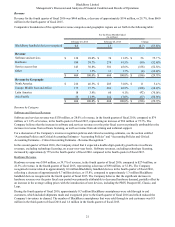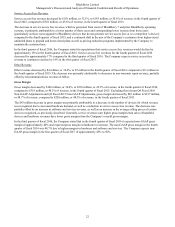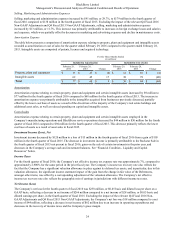Blackberry 2016 Annual Report Download - page 137
Download and view the complete annual report
Please find page 137 of the 2016 Blackberry annual report below. You can navigate through the pages in the report by either clicking on the pages listed below, or by using the keyword search tool below to find specific information within the annual report.BlackBerry Limited
Management’s Discussion and Analysis of Financial Condition and Results of Operations
29
Credit and Customer Concentration
The Company has historically been dependent on a number of significant telecommunication carriers and distribution partners
and on larger more complex contracts with respect to sales of the majority of its products and services. The Company, in the
normal course of business, monitors the financial condition of its customers and reviews the credit history of each new
customer. The Company establishes an allowance for doubtful accounts (“AFDA”) that corresponds to the specific credit risk
of its customers, historical trends and economic circumstances. The AFDA as at February 29, 2016 was $10 million
(February 28, 2015 - $10 million). The Company also purchases insurance coverage for a portion of its accounts receivable
balances. There were no customers that comprised more than 10% of accounts receivable as at February 29, 2016 (February 28,
2015 – no customers that comprised more than 10%). Additionally, there were no customers that comprised more than 10% of
the Company’s revenue in fiscal 2016 (fiscal 2015 – no customers that comprised more than 10%; fiscal 2014 – no customers
that comprised more than 10%). During fiscal 2016, the percentage of the Company’s receivable balance that was past due
decreased by 1% compared to the fourth quarter of fiscal 2015. Although the Company actively monitors and attempts to
collect on its receivables as they become due, the risk of further delays or challenges in obtaining timely payments from its
carrier and distributor partners of receivables exists. The occurrence of such delays or challenges in obtaining timely payments
could negatively impact the Company’s liquidity.
Market values are determined for each individual security in the investment portfolio. The Company assesses declines in the
value of individual investments for impairment to determine whether the decline is other-than-temporary. The Company makes
this assessment by considering available evidence including changes in general market conditions, specific industry and
individual company data, the length of time and the extent to which the fair value has been less than cost, the financial
condition, the near-term prospects of the individual investment and the Company’s ability and intent to hold the debt securities
to maturity. The Company did not record any other-than-temporary impairment charges for the fiscal year ended February 29,
2016.
Please see Note 5 to the Consolidated Financial Statements for additional information regarding the Company’s credit risk as it
pertains to its foreign exchange derivative counterparties.
Disclosure Controls and Procedures and Internal Controls
Disclosure Controls and Procedures
As of February 29, 2016, the Company carried out an evaluation, under the supervision and with the participation of the
Company’s management, including the Company’s Chief Executive Officer and its Chief Financial Officer, of the effectiveness
of the design and operation of the Company’s disclosure controls and procedures, as defined in Rules 13a-15(e) and 15d-15(e)
under the U.S. Exchange Act. Based on that evaluation, the Chief Executive Officer and the Chief Financial Officer have
concluded that, as of such date, the Company’s disclosure controls and procedures were effective to give reasonable assurance
that the information required to be disclosed by the Company in reports that it files or submits under the U.S. Exchange Act is
(i) recorded, processed, summarized and reported, within the time periods specified in the SEC’s rules and forms, and
(ii) accumulated and communicated to management, including its principal executive and principal financial officers, or
persons performing similar functions, as appropriate to allow timely decisions regarding required disclosure.
Management’s Report on Internal Control Over Financial Reporting
Management of the Company is responsible for establishing and maintaining adequate internal control over financial reporting.
Internal control over financial reporting is defined in Rule 13a-15(f) and 15d-15(f) under the U.S. Exchange Act as a process
designed by, or under the supervision of, the Company’s principal executive and principal financial officers and effected by the
Board, management and other personnel to provide reasonable assurance regarding the reliability of financial reporting and the
preparation of financial statements for external purposes in accordance with U.S. GAAP and includes those policies and
procedures that:
• pertain to the maintenance of records that in reasonable detail accurately and fairly reflect the transactions and
dispositions of the assets of the Company;
• provide reasonable assurance that transactions are recorded as necessary to permit preparation of financial
statements in accordance with U.S. GAAP, and that receipts and expenditures of the Company are being made
only in accordance with authorizations of management and directors of the Company; and
• provide reasonable assurance regarding the prevention or timely detection of unauthorized acquisitions, use or
dispositions of the Company’s assets that could have a material effect on the Company’s financial statements.
On October 30, 2015 and September 22, 2015, the Company completed the acquisitions of Good and AtHoc, respectively,
which are included in the fiscal 2016 consolidated financial statements of the Company and constituted 19% and 23% of total
and net assets, respectively, as of February 29, 2016, and 3% and 13% of revenues and net loss before tax, respectively, for the


